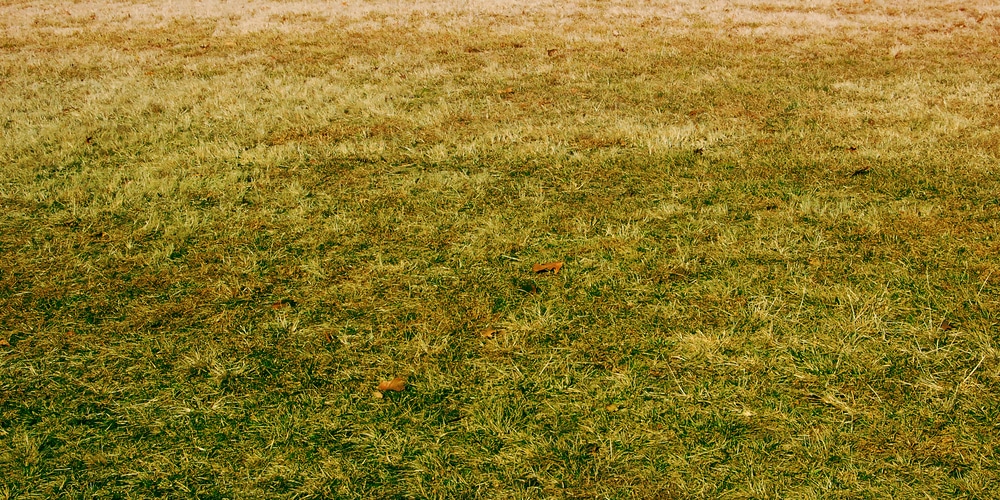It’s a common sight at this time of year to see yellow patches on your lawn. Most warm season grasses, such as Bermuda, turn dormant when temperatures drop below 50 degrees Fahrenheit. In fact, most grass turns yellow in winter.
Many homeowners think their grass is dead when it turns yellow, but this isn’t the case. Warm season grasses are used to growing actively during the hot summer months.
When cold weather rolls in, their growth slows down, and the grass becomes dormant until springtime returns warmer temperatures. It’s important to know which type of grass you have in your yard before the winter sets in.
Let’s look at which type of grass turns yellow in winter and discuss some other reasons, such as fungal disease that could cause the grass to yellow.
Grass turning yellow in winter

A lot of the new breed warm season grasses, such as buffalo lawns and zoysia grass, can handle a little bit cooler temperature. However, if frost is expected and the temperatures begin to fall, it’s most likely that these grass varieties will go dormant and turn yellow.
Yellowing grass in the winter months is natural and nothing to worry about. Warm season grasses aren’t able to cope with the colder weather and will become discolored. If you want your lawn to stay greener for longer, you should ensure you take good care of your grass during the growing season.
Regularly watering, fertilizing, mowing, and aerating your lawn will help create a deep root system and healthy grass. Lawns that are dense and healthy will stay greener longer. Grasses such as Bermuda and Zoysia may even remain green for much of the winter in some climates.
If you live in an area where frost is likely and have Bermuda grass, it’s best to overseed your lawn with winter rye in November or December. The rye will germinate and grow in the cooler weather and fill in patches for you for a lush green lawn.
When warmer temperatures return, in March or April, it’s time to start mowing the rye down. This gives your Bermuda grass enough time to grow back before summer. Overseeding in this way will allow you to grow a green lawn year-round.
Which grass varieties turn yellow in the winter?
Bermudagrass, St. Augustine grass, Zoysia grass, Centipede grass, Buffalograss will all turn yellow during the cold winter months if you live in an area that has cold temperatures below 50F.
Warm-season grasses have their growing season from the early spring until the late fall; during this time, the grass will look green and healthy. As the weather gets colder, the grass will become dormant and start to turn yellow. In some cases, if frost is present for long periods, grass may turn brown and die completely. Winter kill can be caused by low temperatures or cold winds.
Other reasons grass may be turning yellow in winter?
Grass can also turn yellow during the winter months due to fungal infections or salt build-up in the soil.
Snow mold
Common fungal infections include Microdochium nivalis, which is usually referred to as snow mold. This fungal disease affects turf grass, such as tall fescue and Kentucky bluegrass, in damp conditions when the snow melts slowly. The fungus infects the plant’s shoots and blades, causing them to turn yellow or brown.
It can also damage roots if extended periods of wet weather follow heavy snowfall. Snow mold can be a big problem. It is more prevalent on shaded lawns, but it will occur whenever prolonged periods of cold temperatures are followed by warm days that melt the snow.
Salt Build up
In the winter, salt is often used on sidewalks or walkways to melt ice. In some areas, the salt may be washed into the earth by heavy rainfall and could cause the grass to turn yellow. In the worse cases, this could kill the grass.
Conclusion
Warm season grasses will turn yellow in the winter if your area is hit with temperatures below 50 degrees Fahrenheit. If you want to keep your grass healthy and green through the cold weather, you should overseed with rye at the end of fall.
This will fill in any patches of dead grass while providing a lush green lawn for most of the winter. Once the rye begins to grow, mow it down in March or April before your Bermuda grass can get a chance to grow back. With proper lawn care, you should be able to keep your grass green all year round.